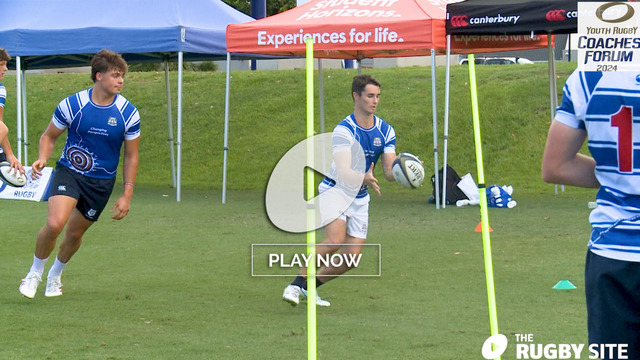Articles
Attack articles
Want to teach your players attacking rugby?
We have got attacking skills resource for all levels of the from some of the world's best attack coaches to help including Wayne Smith, Joe Schmidt, Gregor Townsend, Dave Ellis and others.
- Build an effective attack strategy like the best attacking teams in the world.
- Understand different strategies and why they are effective.
- Develop effective individual and team attacking skills and tactics.
- Different modified games to develop attacking skills.
Plus we have categorised them by playing level to make it easier for you to find:
- Y – youth
- HS – high school
- A – adult
- All – suitable for all levels
Upwardly mobile or treading water? Are Razor’s All Blacks still on trend?Has Scott Robertson’s All Black’s abandoned Sir Wayne Smith’s highly successful ‘counter attack’ principles?
Nick Bishop compares the current iteration All Blacks against its Rugby Championship counterparts for answers
What the new ‘escort’ rules mean for aerial contestablesThe new rules for ‘escort runners’ has created an unintended consequence and a far more open and less structured situation for both sides as Nick Bishop reports.
How to use the new scrum guidelines to free your attacking #9Nick Bishop outlines how new rules for the defending 9 at the scrum have created more 8/9 attack options.
Why a counter-intuitive kick can be the red zone panaceaUsing last weekend’s France vs Wales 6 Nations match Nick Bishop illustrates why it is important to open the mind and keep all options open, including kicking, to overcome the ‘Offensive claustrophobia’ as it can it can offer the cleanest outcomes.
How to work a modern pod system with LQBModern pod systems have been transformed by the new breakdown guidelines. Nick Bishop looks what effects they are having on on current attack structures.
Why more access to the high ball makes for a better game of rugbyRemoving the ‘glove defence’ results in a much cleaner and quicker development of the play, as evidenced by Nick Bishop in this week’s analysis.
How to shuffle the deck close to the goal-lineAnalyst Nick Bishop illustrates how the ‘use it or lose it’ mindset now applied (under the new law), to “The ball is played or taken into in-goal by an attacking player and is then held up”, is promoting more attacking innovation.
How to exploit the ELV on defensive scrum-halves [from scrum] – part 2Nick follows on from his earlier article on how the scrum has now became a favourite weapon of attack and the short-side was the red-hot area target zone.
How to exploit the ELV on defensive scrum-halvesNick Bishop evaluates the possible effect of the new ELV – shielding of the attacking scrum-half from interference at ruck and maul, introduced at the start of the RC2024.
How to work the latest gadget play in short-range attackOne of the latest trial laws insists that it will no longer be possible to choose a scrum from a free-kick. Nick Bishop looks at what innovations may result especially close to opposition’s goal line.
How England upset Ireland’s Grand Slam plans at TwickenhamNick Bishop details the key ingredient that led to England’s upset 6N win over 6 to 1 favourite and Grand Slam-elect Ireland.
How to attack wide – the Toulouse way!The best attacking teams in the current era never take the apparent space they are offered on the edge without checking, or switching inside first.
How to create early attacking options from the “21”If your charges can learn to run one play exceptionally well, you will force opponents to adjust to it – and that will create opportunities elsewhere.
As Nick Bishop evidences in Racing 92’s match against fellow Top 14 side Toulon.
How to run a two-phase switchback attack with optionsNick Bishop looks at how leading teams are creating multiple threats early in the phase-count, and sustaining those threats for longer on attack than the defence can successfully manage them.
What the raw statistics from the RWC say about the attack-defence balance in the global game [part 2]Nick Bishop looks in more detail at what happened when teams of the same general type played one another, or two sides of opposite approach clashed.
How to find a simple attacking solution from set-pieceCoaches at all levels of the game, and in all sports are always looking for simple, robust solutions that work – the simpler, the better.
Nick Bishop details what Set Piece Strike Play is working for a number of teams to date in the RWC2023.
How to find the right roles for twin number 10’sMost number 10’s are either strategist/game-managers or they are instinctive ball-players.
Nick Bishop looks at how England are successfully fitting their number 10 ‘strategist’ and ‘wizard’ into their starting lineup and attack structure.
What does good multi-phase offence look like?You do not have to win the lion’s share of collisions in order to play winning attacking rugby.,
It is still possible to find space in multi-phase attack if you have the will, the structures and the personnel to do it.
Using No 1 ranked Ireland and their recent RWC match against Romania as the example, Analyst Nick Bishop explains how it can be done.
How to win the #15/ #9 battle from midfield scrumsLaw changes frequently have repercussions, or send out impact ripples well beyond the original intention – for better or for worse. As Nick Bishop highlights how the Defending #9 not being allowed past the mid-line of the scrum trial law change has also changed how the backs attack and defend.
Why teams are feeling the need – the need for speed – at the scrum base [part 2]Nick Bishop highlights how the new law-trial requiring the defending scrum-half to drop back rather than chase up beyond the mid-point of the set-piece are having more of a positive impact than even the law-makers may have envisaged.
How to design and develop a ‘gadget’ move from lineoutInnovation can be the genuine discovery of something completely new, but far more often it represents the improvement, or streamlining of something already known.
Nick Bishop looks at how the ‘Teabag’ (lineout gadget play) has evolved as coaches ‘innovate’ the same concept from another angle.
How the new law trial at the scrum is creating new possibilities for the attackNick Bishop highlights some new ideas to create clean attacking ball from scrums encouraged by the latest law-trials, and (potentially) the scrummage returning to its former status as a potent attacking weapon.
How to get into shape on attack and use your ‘spares’ – the modern way!The speed of modern ruck ball has now increased to a point where formations have had to become more flexible to maintain momentum and fan the flames on attack. Nick Bishop details why this has come about and its effect on game.
How to run the “I” formation and mask your intentions on attackNick Bishop details how Italy has extended the ‘I’ attack formation to great effect in their recent international matches.
How to turn a profit from off-the-ball work on kick returnsIt takes a lot of hard work to create a platform to unlock a good opposing kicking game, and the chase which backs it up, on counter-attack.
Using Scotland’s 6 Nations performance against England at the weekend, Nick Bishop outlines what is involved and the potential returns from the off the ball hard work.
How to move the point of contact close to the goal-lineIf you play it safe, it can often lead to the sporting syndrome of ‘tightening up’ psychologically. Typically, sportsmen turn to increased focus on the detail of their performance, a technical hypervigilance – and that only makes things worse.
Nick Bishop looks at the expectations of scoring a try close to the goal-line.
How to use ‘lightning quick ball’ at the Lineout DriveThe principles of LQB and KBA don’t have to be confined to the skills of offloading and quick ruck ball production in open play.
Nick Bishop, Leinster and soon to be Racing 92 analyst, starts the year using footage from the clubs’ recent match, how Lightening Quick Ball can be used at lineout time.
How to work around a dominant maul defender on attackThe ability to establish a dominant maul defender is key for the defence, and as Nick Bishops details it is equally vital for the attacking side to formulate alternate strategies to overcome that dominance once it has been proven.
How the Professor’s good teachings influenced the All Blacks at TwickenhamDeliberately or not, there was a transmission of essential I.P from the Black Ferns RWC coach Wayne Smith ‘the Professor’ to the All Blacks at Twickenham As Nick Bishop illustrates in this week’s analysisa
The absolute clarity about the ‘where’ and ‘how’ of the attackWayne Smith’s highly successful, and exciting, ‘where’ and ‘how’ attack clarity was very much in evidence during the Black Ferns recent group match against Wales, as Nick Bishop details in this week’s analysis.







